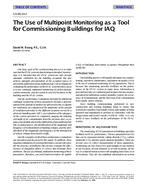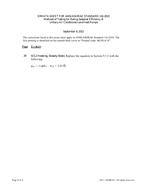Click here to purchase
Cool thermal energy storage systems enable the decoupling of the electrical demand associated with cooling systems from the demand for cooling. They typically use ice storage modules or a stratified chilled water tank to store thermal energy during favorable chiller operating periods. The operational degree of freedom granted by these systems allows for optimization objectives which are aligned with those favorable chiller operating periods. Possible objectives are operating cost based on dynamic electricity rates and utilization of renewable electricity. These two objectives are related in that electricity rates can be made increasingly adaptive to the intermittent availability of renewable resources, typically solar and wind. This paper describes the use of model predictive control (MPC) to optimally control a cooling system with stratified chilled water storage and a water-cooled centrifugal chiller. Linear programming is used along with linearized simulation inputs. The building cooling loads to be met are defined by a prototypical large office building located in New York City. The inputs are considered to be perfectly forecasted and the optimization is performed once each simulation day. The optimization objective is operating cost based on either day-ahead or real-time rates for this location. Two different rates are used to evaluate the hypothesis that MPC will achieve better results with increasingly variable inputs. The baseline against which the simulations are compared is a simple strategy that idles the chiller system based on one rate threshold. The hourly day-ahead rate is a prediction of the following day’s rates while the real-time rate is not charged to end customers, but it contains the actual rates which the day-ahead rate predicted. Both rates have the same mean value, but the standard deviation is two-and-a-half times greater for the real-time rate. The real-time rate provides a surrogate for future day-ahead rates in areas with high penetration of renewables on the electric grid. When applying the day-ahead rate, the annual electricity cost is reduced by 11% when using the MPC strategy as compared to a single-threshold control strategy. By comparison, the MPC strategy results in a 24% cost reduction with the real-time rates applied. While both scenarios experience significant electricity cost savings, they are increased more than two-fold with the more dynamic rate. This indicates that MPC strategies are increasingly beneficial with progressively variable inputs and that utility systems can take advantage of optimized controls to assist in load balancing with an increasingly renewable generation mix.
Citation: 2019 Annual Conference, Kansas City, MO, Conference Papers
Product Details
- Published:
- 2019
- Number of Pages:
- 8
- Units of Measure:
- Dual
- File Size:
- 1 file , 5 MB
- Product Code(s):
- D-KC-19-C035


